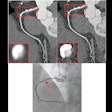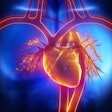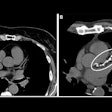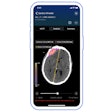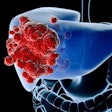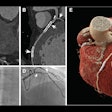A study in the December 19 Journal of the American Medical Association confirms that CT pulmonary angiography (CTPA) is a reliable alternative to ventilation-perfusion (V/Q) scans for ruling out pulmonary embolism (PE). CT doesn't miss clinically significant blood clots in the lungs, and can also help reveal other potential causes of the patients' symptoms, the authors report.
Dr. David Anderson and colleagues from Dalhousie University in Halifax, Nova Scotia, Canada, are certainly not the first authors to see advantages in CTPA. Since its introduction a decade ago, CTPA has been adopted rapidly into clinical practice, while V/Q scans with their often inconclusive results have dwindled in number.
However, Anderson and colleagues led a particularly large and carefully designed study that further examined patients with inconclusive V/Q tests using ultrasound. Not only did CT diagnose more PE at baseline compared to V/Q scans, patients randomized to V/Q developed more than twice as many pulmonary emboli during the three-month follow-up period.
"For 30 years, ventilation-perfusion lung scanning has been the noninvasive imaging procedure of choice in patients with suspected pulmonary embolism," wrote Anderson and colleagues. "However, in most patients in whom PE is suspected, V/Q scans are either of low or intermediate probability.... The diagnostic uncertainty in these situations is a major limitation of V/Q scanning" (JAMA, December 19, 2007, Vol. 298:23, pp. 2743-2753).
CTPA, with reported sensitivities ranging from 53% to 100%, has emerged in the past decade as an attractive alternative because it provides a clear diagnosis, and with thin-section multidetector-row CT scanning, sensitivity has risen markedly in recent years. Its high radiation dose remains a trouble spot, however. And CTPA has never been compared directly to V/Q scanning, according to the authors.
Anderson and colleagues randomized patients with suspected PE (Wells clinical model score of 4.5 or greater and a positive D-dimer test) to either V/Q scanning (n = 716) or CTPA (n = 701).
For patients randomized to CT, noncontrast images of the entire thorax were acquired first (using 1-mm collimation, 280 mAs, 140 kVp, 10-mm reconstructions) to help exclude alternative diagnoses. Then, following administration of 150 mL of iodinated contrast (Omnipaque 240, GE Healthcare, Chalfont St. Guiles, U.K.) CT images of the thorax were obtained at 3-mm intervals (single slice) or 1.25-mm (multislice) in a single breath-hold.
Patients with positive CTPA scans or high-probability V/Q results were considered to have pulmonary embolism, while those with negative CTPA or normal V/Q scans were considered to have PE excluded. Others, including patients with inconclusive V/Q results underwent ultrasound imaging of the proximal venous system to assess for deep venous thrombosis (DVT).
More cases were diagnosed and treated with anticoagulant therapy in the CT group -- a total of 133 patients (19.2%) in the CTPA group versus 101 (14.2%) in the V/Q group (difference 5.0%, 95% CI: 1.1% to 8.9%), according to the authors.
Moreover, among patients in whom PE was considered excluded, two of 561 patients (0.4%) randomized to CT developed venous thromboembolism in the follow-up period, compared to six of 611 (1.0%) randomized to V/Q scans (difference 0.6%; 95% CI, -1.6% to 0.3%). One patient with a negative V/Q scan had a fatal PE during the follow-up period.
"An unanticipated finding in our study was that CTPA resulted in a significantly greater number of venous thromboembolism diagnoses than did V/Q scanning," Anderson's group noted.
Still, the authors believe that V/Q should still play a role in ruling out PE. V/Q scanning "involves much less radiation exposure and has fewer adverse effects and contraindications than CTPA," they wrote. In addition to the generally high radiation dose associated with CTPA, many patients have contraindications to iodinated contrast.
"The results of our study are reassuring given previous reports of relatively low sensitivity of CTPA for the diagnosis of pulmonary embolism,” the authors wrote. "Consideration should be given to performing CTPA for patients with nondiagnostic V/Q scans at high clinical likelihood for pulmonary embolism."
And while the two diagnostic algorithms yielded low and similar rates of thromboembolic events over the three-month follow-up period, "significantly more patients were diagnosed and treated with CTPA than V/Q scanning," the authors noted. "Further research is required to confirm whether some pulmonary emboli detected by CTPA may be clinically unimportant, the equivalent of deep vein thrombosis isolated to the calf veins, and not require anticoagulant therapy."
In an editorial accompanying the study, Dr. Jeffrey Glassroth from Northwestern University in Chicago found the study reassuring in that it confirmed the value of a test that has already come into widespread use. However, he was less certain that clinicians would know precisely what to do with all of the additional PE diagnoses resulting from CTPA scans, particularly considering the risks associated with anticoagulation therapy, and the fact that small, subsegmental emboli likely to be picked up by thin-section CT are not always fatal (JAMA, December 19, 2007, Vol. 298:23, pp. 2788-2789).
Pending additional studies to assess the precise risks and benefits of treating the small emboli CT is finding in large numbers, whether to treat some of these patients "will have to remain a decision made on a case-by-case basis for now." Glassroth wrote.
By Eric Barnes
AuntMinnie.com staff writer
December 18, 2007
Related Reading
Low-dose CT yields equivalent value for PE in pregnancy, November 27, 2007
V/Q scan finding reliably excludes pulmonary embolism, September 28, 2007
Researchers scrutinize CTA for pulmonary embolism, July 16, 2007
Pulmonary embolism an uncommon cause of COPD flare, March 6, 2007
Triple-rule-out CT yields even contrast enhancement, January 22, 2007
Copyright © 2007 AuntMinnie.com








